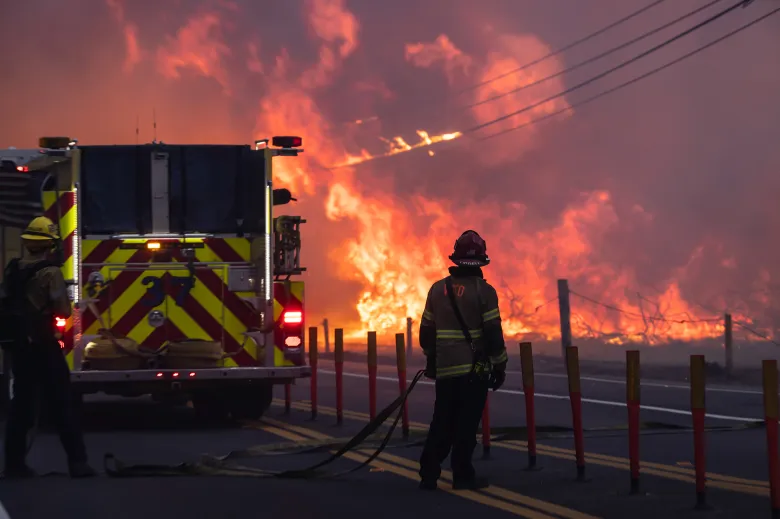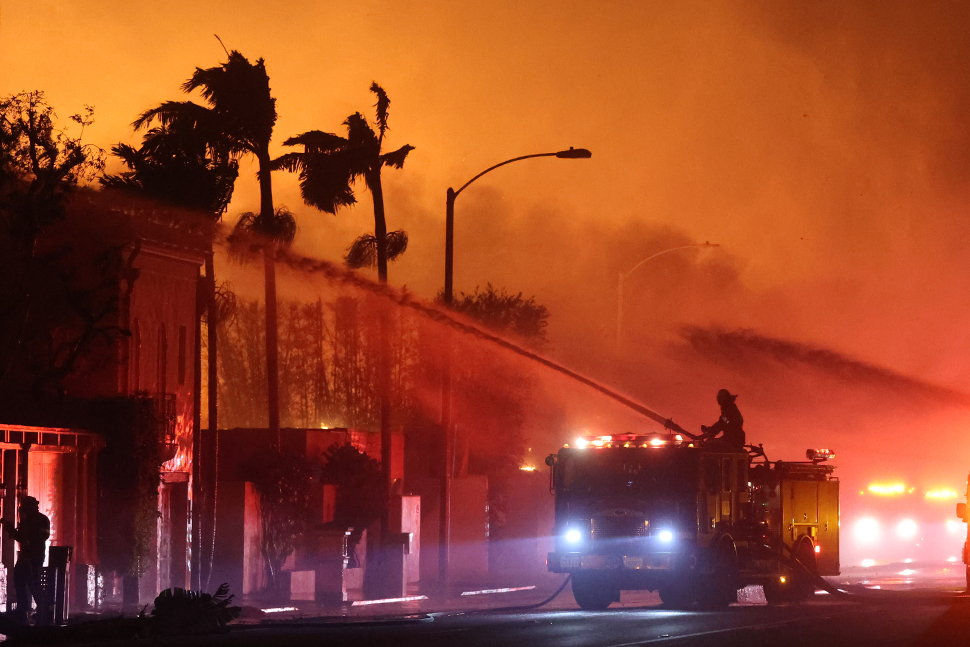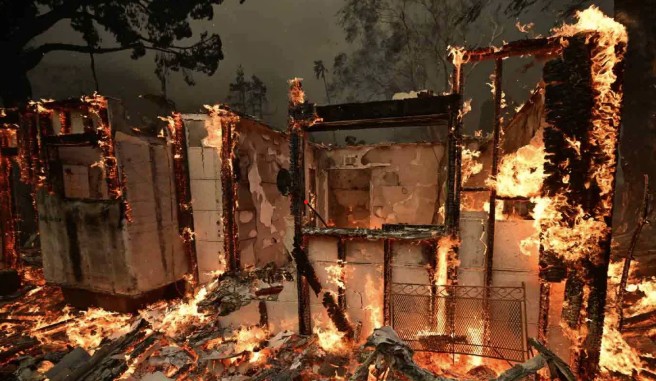Insufficient evacuation routes and often no warning for residents of the approaching flames during the Eaton and Palisades Fires. Thirty-one people were killed. Read the list below and a common factor emerges.
ALTADENA
Oswald Altmetz, 75
Carolyn Burns, 56
Edwin Cridland, 94
Dalyce Curry, 95
Stacy Darden, 54
Kevin Devine, 54
Miva Friedli, 86
Erliene Kelly, 83
Barbara Lewis, 84
Evelyn McClendon, 59
Patricia McKenna, 77
Anthony Mitchell, Sr. early 70s
Justin Mitchell (son—born with cerebral palsy)
Rodney Nickerson, 82
Victor Shaw, 66
Lora Swayne, 71
Kim Winiecki, 77
Zhi Feng Zhao, 84
19th victim unidentified
PALISADES FIRE:
Randall Miod, 55 (Malibu)
Elizabeth Morgan 79
Charles Mortimer, 84
Betty O’Meara, 94 (Malibu)
Annette Rossilli, mid-80s
Mark Shterenberg, 80
Arthur Simoneau, 69 (Topanga)
Rory Sykes, 32 (Malibu) – (blind and cerebral palsy)
Jeffrey Takeyama 69 (Malibu)
Diane Webb, 82 (Malibu)
Hak Wong, 69
Unidentified body found on Lomas Avenue
Of the 19 people found dead in Altadena, 12 are older than 70. In Pacific Palisades, of the 12 people who died, 9 are older than 69. The elderly and handicapped died in disproportionate numbers in the fires. Why were they not evacuated?
UNINCORPORATED LA COUNTY:
The people in the western-most part of the Palisades Fire, in the unincorporated area of Malibu about a mile north of Pacific Coast Highway, lacked emergency notice. That area is under the jurisdiction of L.A. County.
“I remember making a strong cup of black tea to stay awake because from my bedroom window, I could see the flames below on PCH,” Dr. Birute Anne Vielisis, 84, told CTN. She is a 37-year-resident of the Los Flores Canyon area.
Her friend who lived in Big Rock, said that they had received an evacuation notice about noon when a police vehicle came up and down the streets and over a loudspeaker told everyone to leave, “If there is anyone still in Big Rock, you must evacuate now.”
Vielisis, who, has a bachelor’s degree in English literature from the University of Vermont, studied fine arts in Italy and has a Ph.D. from Princeton University in the history of art, said that her area received no evacuation warning.
“No one came by to warn us,” she said. That area of the county lost power around 1 p.m. and there was no cell reception.
She evacuated around midnight when a neighbor came and knocked on her door and said he thought they should leave. “I shudder to think that if he hadn’t come down to get me, I might have fallen asleep,” Vielisis said.
A December 2024 Westside Current story pointed out (“Facing Flames and Blackouts: Supervisor Horvath’s Silence Deepens Fire Survivors Struggles”) “In unincorporated areas, where resources are already limited, many are forced to rely on makeshift solutions such as handheld radios or driving miles to access cell service.”
“When the power goes out, either a mandated shutoff or the result of an emergency, there is a complete loss of communication. When the electricity goes out, cell towers and internet services often fail, cutting residents off from vital information about emergencies.”
Horvath never responded to the Current’s request for comment.
ALTADENA:
In a January 24 Capital B story (“Why Were Black Altadena Residents Not Warned to Evacuate in Time?”) wrote that the neighborhood west of Lake Avenue didn’t receive evacuation orders for hours. “Seventeen residents, including Kelley, many of them older or with mobility challenges, died in an inferno they never knew was closing in.” The story noted a poor emergency alert system.
The Eaton Fire started at 6:15 p.m. on January 7, and residents in East Altadena received their first evacuation notice at 6:40 p.m. that same night. West Altadena received no notice.
If not for What’sApp pickleball group, the number of deaths might have been far higher in West Altadena.
Kathy Aicher, a pickleball player, was told by her neighbor around 6:15 p.m. that there was a fire. She looked out a window and saw the mountain on fire. As she and her mother collected belongings, Aicher tried to think of a way to let people know. The Orange County Register wrote click here that she went to the WhatsApp Pickleball group and wrote “Everyone look up there’s a vegetation fire on Canyon Close. So if you’re anywhere near Eaton Canyon, I’d evacuate. We are.”
Her message got through to Joy Chen the pickleball WhatsApp administrator, around 6:24 p.m.
“From that moment, our WhatsApp became a real-time evacuation network. We helped each other locate the fire, alert neighbors, even hose down houses,” said Chen a former deputy mayor of Los Angeles.
In West Altadena, which is more heavily Black. Latino and Asian, residents didn’t receive County evacuation orders until 3 a.m. Wednesday, January 8.
“By morning, our Club was gone. Half our homes were gone. But everyone in the pickleball WhatsApp had gotten out safely. Nineteen people died in Altadena, but not a single member of our WhatsApp,” Chen said. “We call it our lifesaver.”
Chen and her family live in West Altadena, in the last section to get the official cellphone alert, which came at 5:42 a.m. on Wednesday. “But we evacuated Tuesday night thanks to the WhatsApp.”
Altadena is unincorporated and under the L.A. County Evacuation system. To receive alerts County residents need to register for Emergency Notifications that then go out by text, email or phone call. Additionally, the Emergency Alert System goes directly to radio and television carriers.
How does the County alert people if they haven’t signed up for the alerts, have their cell phones turned off or have already gone to bed and are not listening to the radio and television?
Possibly the County Sheriff’s can go door to door? Chen asked the new acting captain Ethan Marquez what happened. She said he sent sheriffs door to door, but it was too dangerous.
PACIFIC PALISADES
The death toll could have been much higher in Pacific Palisades had the fire broken out at 10:30 p.m. rather than 12 hours earlier. Even then, evacuation warnings were sketchy.
Highlands resident Joe Halper, who was a former member of the Rec and Park Board of Commissioners, was working on his computer and unaware of the January 7 morning fire. “No one [police] knocked at my door,” he said. It was only after he received a phone call around noon from his wife Arline who was down in the Village. She told him about the fire and to leave.
The Palisades Highlands also has sketchy cell phone reception, so alerts and other calls may not go through to residents. That means the City of LA’s Emergency Alert System, Notify LA, which sends alerts via phone, email or text, may not have gone through to numerous people.
Additionally, if a resident has not signed up for these alerts, one doesn’t receive them.
At 12:30 p.m., Halper, 95, was able to easily drive down Palisades Drive and evacuate, two hours after the start of the fire. Most residents had left earlier when flames were on both sides of the road. When those cars reached Sunset Boulevard, there was gridlock, and all were told to leave their cars and run to the beach.
The cars jammed Sunset Boulevard making it impossible for first responders to access much of the Palisades because there are only three roads, in and out of the Palisades (Sunset, Temecal Canyon Road and Chautauqua Boulevard).
When messages erroneously went out about evacuation orders, officials urged people to “please review the map of evacuations on Alertla.org.”
Especially in the mountains, or residents adjacent to the mountains, people during fires often have no power, which means no computer to check alerts, no television. Cell towers can be down, which means no phones, no texts, making it hard to review any evacuation map.
A Palisades Marquez resident Deeann Wilken heard an LAPD police car, with a speaker driving up Livorno, in the late morning January 7 telling people to evacuate. But “I was outside, so I heard them, if I had been in my house, I wouldn’t have,” Wilken said and noted she saw the car only go up one street before turning around and coming back.
If LAPD or County Sheriffs cannot knock on thousands of doors to evacuate people, what’s the alternative?
Five years ago, the California State Auditor was tasked with looking at emergency plans for safe and efficient evacuation of residents with access and functional needs in counties that have experienced natural disasters. The report “California Is Not Adequately Prepared to Protect Its Most Vulnerable Residents from Natural Disasters (click here.)
It was recommended that the legislature should require CAL OES (California Governor’s Office of Emergency Services) to review all counties’ emergency plans to determine if they are consistent with best practices. And that “each county should adopt county ordinances that require it to adhere to the best practices and guidance issued by FEMA, Cal OES, and other authorities when conducting such planning.”
The document notes that “Cal OES has not completed after action reports for the vast majority of natural disasters that have occurred in the last five years, and it has not broadly disseminated lessons learned from those disasters.”
The County of Los Angeles Office of Emergency Management was contacted and CTN was told it last updated its Emergency Operations Plan in 2023 and it was approved by Cal OES in September and by the Supervisors in November 2023. This editor looked for specific emergency evacuation notices that dealt with lack of power or that did not use cellphones or technology. I also looked for plans to get the elderly or disabled out of an area, but could not find any click here.



